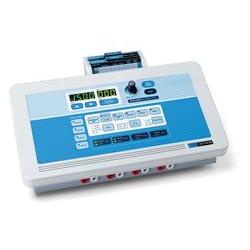Electrical Therapies
Modern state of the art electronics have been recently designed to provide a painless and effective form of treatment in the chiropractor's office.
Treatment in your case may incorporate the use of various pieces of medical equipment to help in your recovery.
Initially forms of interferential or medium frequency current will be used to reduce symptoms such as pain, inflammation (swelling) and spinal dysfunction (improper movement in the spinal joints).

In general electrical stimulation will provide relief by accomplishing the following:
Decrease Pain:
These machines can bring about immediate pain relief by producing an effect in the nervous system, which releases enkephalin (morphine like substances produced by the body).
Electrical stimulation affects specific fibers to produce endorphins, serotonin and anti-inflammatory agents, which provide long term pain relief.
Reduce Inflammation:
Electrical stimulation of injured tissues assists the reduction of inflammation by relieving pressure and irritation caused by (facilitated, irritated or excited) nerves.
Reduce Spinal Dysfunction (fixations and subluxations):
Electrical stimulation provides pre-manipulative preparation of the are by gently loosening the muscles and facilitating motion in the joints.
Increase Joint Mobility:
Electrical stimulation can assist in preparing the are for manipulation by stimulating nerves (mechanoreceptors), which cause a "joint jiggling" motion.
Strength Restoration:
Electrical stimulation can assist strengthening the muscles supporting the joints to promote and maintain required mobility and elasticity as well as assist in reducing fibrotic changes. This is usually started once pain and muscular spasm disappears.
In review, electrical stimulation can be used during the 3 phases of recovery in the following manner:
Phase 1
Pain Relief: To provide relief and reduce symptoms of pain, inflammation and spinal dysfunction.
Phase 2
Restoration (repair and correction): To assist restoring normal spinal functions by further reducing pain, inflammation and increasing circulation. Continue to prepare the pre-manipulative procedure and assist in post manipulative response by strengthening and supporting structures of the spine.
Phase 3
Maintenance: To maintain the patient's normal muscular strength, joint mobility and muscular and connective tissue elasticity achieved through previous treatments.
